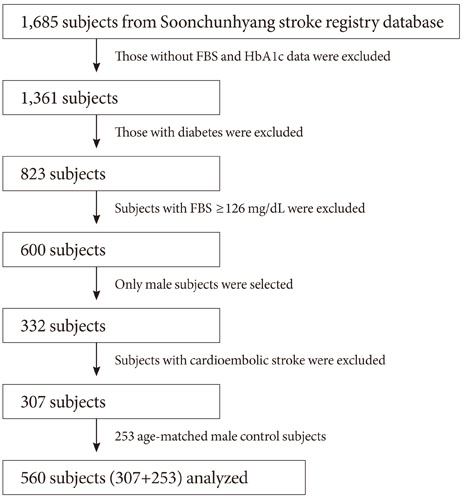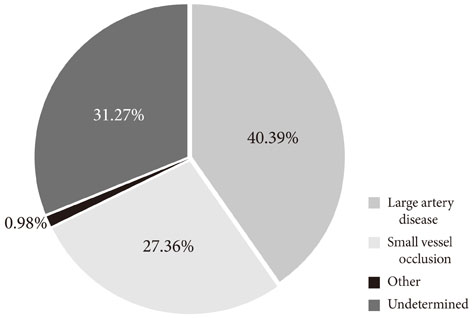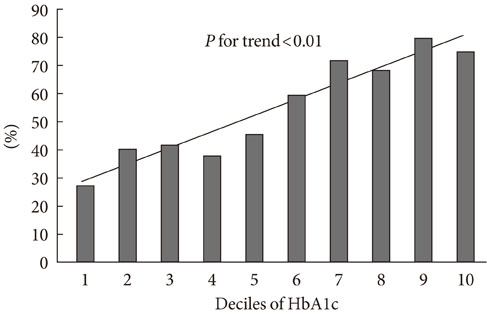Diabetes Metab J.
2011 Oct;35(5):551-557. 10.4093/dmj.2011.35.5.551.
Higher Glycated Hemoglobin Level Is Associated with Increased Risk for Ischemic Stroke in Non-Diabetic Korean Male Adults
- Affiliations
-
- 1Department of Neurology, Soonchunhyang University College of Medicine, Cheonan, Korea.
- 2Department of Endocrinology and Metabolism, Kangbuk Samsung Hospital, Sungkyunkwan University School of Medicine, Seoul, Korea. hongsiri@hanmail.net
- KMID: 1857512
- DOI: http://doi.org/10.4093/dmj.2011.35.5.551
Abstract
- BACKGROUND
The role of glycated hemoglobin (HbA1c) in the prediction of ischemic stroke in non-diabetic subjects is not clear. We performed a study to analyze the role of HbA1c in the risk prediction of ischemic stroke in non-diabetic Korean males adult.
METHODS
A total of 307 non-diabetic male patients with ischemic stroke were enrolled, and 253 age-matched control subjects without a history of diabetes, hypertension, or cardiovascular disease were selected from a Health Check-up database. Anthropometric measurement data, fasting glucose level, lipid profile, and HbA1c level were available for all subjects. Associations of the variables and the presence or absence of ischemic stroke were analyzed.
RESULTS
The ischemic stroke patient group had significantly higher HbA1c levels (5.8+/-0.5% vs. 5.5+/-0.5%, P<0.01) and mean systolic and diastolic blood pressure compared with the control group. Among the variables, smoking, low high density lipoprotein cholesterol, systolic blood pressure, and HbA1c were the significant determinants for ischemic stroke. The highest quartile of HbA1c showed a 9.6-fold increased odds ratio for ischemic stroke compared with the lowest quartile of HbA1c (odds ratio, 9.596; 95% confidence interval, 3.859 to 23.863, P<0.01). The proportion of ischemic stroke patients showed a significant trend for increment as the deciles of HbA1c increased (P for trend <0.01).
CONCLUSION
Higher HbA1c indicated a significantly increased risk for ischemic stroke after adjusting for other confounding variables in non-diabetic Korean adult males. HbA1c might have significance in predicting the risk for ischemic stroke even in the non-diabetic range.
Keyword
MeSH Terms
Figure
Cited by 1 articles
-
Glycated Hemoglobin is a Better Predictor than Fasting Glucose for Cardiometabolic Risk in Non-diabetic Korean Women
So Ra Yoon, Jae Hyang Lee, Ga Yoon Na, Yu Jeong Seo, Seongho Han, Min-Jeong Shin, Oh Yoen Kim
Clin Nutr Res. 2015;4(2):97-103. doi: 10.7762/cnr.2015.4.2.97.
Reference
-
1. Burke TA, Venketasubramanian RN. The epidemiology of stroke in the East Asian region: a literature-based review. Int J Stroke. 2006. 1:208–215.2. Ergul A, Li W, Elgebaly MM, Bruno A, Fagan SC. Hyperglycemia, diabetes and stroke: focus on the cerebrovasculature. Vascul Pharmacol. 2009. 51:44–49.3. Ramachandran A, Ma RC, Snehalatha C. Diabetes in Asia. Lancet. 2010. 375:408–418.4. Tahara Y, Shima K. Kinetics of HbA1c, glycated albumin, and fructosamine and analysis of their weight functions against preceding plasma glucose level. Diabetes Care. 1995. 18:440–447.5. American Diabetes Association. Diagnosis and classification of diabetes mellitus. Diabetes Care. 2011. 34:Suppl 1. S62–S69.6. Adams HP Jr, Bendixen BH, Kappelle LJ, Biller J, Love BB, Gordon DL, Marsh EE 3rd. Classification of subtype of acute ischemic stroke. Definitions for use in a multicenter clinical trial. TOAST. Trial of Org 10172 in Acute Stroke Treatment. Stroke. 1993. 24:35–41.7. National Glycohemoglobin Standardization Program (NGSP): List of NGSP certified methods. accessed 2011 Aug 10. Available from: http://www.ngsp.org/docs/methods.pdf.8. Schwartz KL, Monsur JC, Bartoces MG, West PA, Neale AV. Correlation of same-visit HbA1c test with laboratory-based measurements: a MetroNet study. BMC Fam Pract. 2005. 6:28.9. Finke A, Kobold U, Hoelzel W, Weykamp C, Miedema K, Jeppsson JO. Preparation of a candidate primary reference material for the international standardization of HbA1c determinations. Clin Chem Lab Med. 1998. 36:299–308.10. Peterson KP, Pavlovich JG, Goldstein D, Little R, England J, Peterson CM. What is hemoglobin A1c? An analysis of glycated hemoglobins by electrospray ionization mass spectrometry. Clin Chem. 1998. 44:1951–1958.11. Park S, Barrett-Connor E, Wingard DL, Shan J, Edelstein S. GHb is a better predictor of cardiovascular disease than fasting or postchallenge plasma glucose in women without diabetes. The Rancho Bernardo Study. Diabetes Care. 1996. 19:450–456.12. Khaw KT, Wareham N, Bingham S, Luben R, Welch A, Day N. Association of hemoglobin A1c with cardiovascular disease and mortality in adults: the European prospective investigation into cancer in Norfolk. Ann Intern Med. 2004. 141:413–420.13. de Vegt F, Dekker JM, Ruhe HG, Stehouwer CD, Nijpels G, Bouter LM, Heine RJ. Hyperglycaemia is associated with all-cause and cardiovascular mortality in the Hoorn population: the Hoorn Study. Diabetologia. 1999. 42:926–931.14. Blake GJ, Pradhan AD, Manson JE, Williams GR, Buring J, Ridker PM, Glynn RJ. Hemoglobin A1c level and future cardiovascular events among women. Arch Intern Med. 2004. 164:757–761.15. Pradhan AD, Rifai N, Buring JE, Ridker PM. Hemoglobin A1c predicts diabetes but not cardiovascular disease in nondiabetic women. Am J Med. 2007. 120:720–727.16. Selvin E, Coresh J, Shahar E, Zhang L, Steffes M, Sharrett AR. Glycaemia (haemoglobin A1c) and incident ischaemic stroke: the Atherosclerosis Risk in Communities (ARIC) Study. Lancet Neurol. 2005. 4:821–826.17. Selvin E, Coresh J, Golden SH, Brancati FL, Folsom AR, Steffes MW. Glycemic control and coronary heart disease risk in persons with and without diabetes: the atherosclerosis risk in communities study. Arch Intern Med. 2005. 165:1910–1916.18. Selvin E, Steffes MW, Zhu H, Matsushita K, Wagenknecht L, Pankow J, Coresh J, Brancati FL. Glycated hemoglobin, diabetes, and cardiovascular risk in nondiabetic adults. N Engl J Med. 2010. 362:800–811.19. Rivera JJ, Choi EK, Yoon YE, Chun EJ, Choi SI, Nasir K, Brancati FL, Blumenthal RS, Chang HJ. Association between increasing levels of hemoglobin A1c and coronary atherosclerosis in asymptomatic individuals without diabetes mellitus. Coron Artery Dis. 2010. 21:157–163.20. Sung KC, Rhee EJ. Glycated haemoglobin as a predictor for metabolic syndrome in non-diabetic Korean adults. Diabet Med. 2007. 24:848–854.21. Ding EL, Song Y, Manson JE, Hunter DJ, Lee CC, Rifai N, Buring JE, Gaziano JM, Liu S. Sex hormone-binding globulin and risk of type 2 diabetes in women and men. N Engl J Med. 2009. 361:1152–1163.22. Page-Wilson G, Goulart AC, Rexrode KM. Interrelation between sex hormones and plasma sex hormone-binding globulin and hemoglobin A1c in healthy postmenopausal women. Metab Syndr Relat Disord. 2009. 7:249–254.
- Full Text Links
- Actions
-
Cited
- CITED
-
- Close
- Share
- Similar articles
-
- Letter: Higher Glycated Hemoglobin Level Is Associated with Increased Risk of Ischemic Stroke in Non-Diabetic Korean Male Adults (Diabetes Metab J 2011;35:551-7)
- Response: Higher Glycated Hemoglobin Level Is Associated with Increased Risk for Ischemic Stroke in Non-Diabetic Korean Male Adults (Diabetes Metab J 2011;35:551-7)
- Risk factors of ischemic brain stroke in Korean diabetic patients: a retrospective study
- Comparison of Oral Health Status according to Glycated Hemoglobin A1c
- Gender Differences in Risk Factor and Clinical Outcome in Patients with Ischemic Stroke




